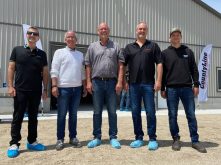Poultry producers across North America should soon have access to expert advice about the most practical, effective ways to deal with euthanasia on their farms.
Why it matters: In both the U.S. and Canada, the past decade has seen enhanced regulation related to on-farm euthanasia, driven largely by a desire to decrease the potential for negative perspectives among consumers. A three-site, three-year, multi-study research project exploring the practice is set to wrap up later this year.
With collaborators at the University of Guelph in Ontario, the University of Saskatchewan in Saskatoon, and Iowa State University in the U.S., the project aims to compile data about how effective different methods are under research study conditions, but also to find out what producers perceive as working or not working on the farm.
Read Also

Jennifer Hayes appointed for second term as the Chairperson of the Canadian Dairy Commission
Jennifer Hayes has been re-appointed as Chairperson of the Canadian Dairy Commission by Heath MacDonald, Minister of Agriculture and Agri-Food.
Speaking to Farmtario during the recent 11th annual Research Symposium of Guelph University’s Campbell Centre for the Study of Animal Welfare (CCSAW), Senior Research Associate Stephanie Torrey said the Ontario Broiler Hatching Egg and Chicken Commission was a big supporter in getting the project up and running in this province. But other producer groups including Chicken Farmers of Ontario, Egg Farmers of Ontario and Turkey Farmers of Ontario have also jumped on board.
Torrey says barbiturate injection, as might be undertaken by a veterinarian for someone’s pet cat or dog, is seen as the “gold standard” for minimizing pain and suffering. This is both impractical and cost-prohibitive, however, under mid-scale to large-scale poultry production management. But the research project’s work so far provides good evidence that both captive bolt-style equipment like the TED (Turkey Euthanasia Device) and administration of carbon dioxide — either by immersion into a pre-filled chamber or the filling of a sealed-off space — can rival injection in terms of some animal welfare parameters.
Separate studies within the project have examined aspects related to euthanasia in layer chickens, broiler chickens and turkeys (but not ducks), both as young and adult birds.
“It’s not nice, but it’s something athat producers have to do,” Torrey said of on-farm deaths administered by poultry farmers to individuals that are injured, infected, or in distress. She added producer groups support the work because they want farmers to be able to make the best choice of method under their particular circumstances, and to be able to carry out that choice in a manner known to be most effective to minimize suffering.
“Ultimately, it is about fine-tuning the methodology,” said Torrey, who chaired the morning session at this year’s CCSAW Research Symposium. Two of the three student presentations during the session related to euthanasia, with Torrey acting as one of the faculty advisors on both.
Studying at Guelph as a foreign student from Spain, Elein Hernandez looked at the process to brain death in turkeys. Hernandez’s study attempted to compare becoming brain dead to other actions common as birds lose consciousness and die. Her 15-minute talk led to a question from the audience wondering whether or not it might be more appropriate from an animal welfare point of view to study “time to consciousness” versus “time to death.”
The poultry euthanasia project also got some exposure during the CCSAW Research Symposium’s “Poster Presentations” session. One of the poster presenters was Masters student Logan Patterson, from Morrisburg, Ont. Her study, just getting underway, is entitled “Assessing the welfare of turkeys euthanized with carbon dioxide under different fill rates.”
“Turkey poults one day, three days, seven days and three weeks of age will be used,” explained her poster. “Treatments are the four gas fill rates (three, six, nine or 12 litres per minute) or immersion in a pre-filled chamber.”
“Previous research on mammalian species has shown that different gas fill rates influence animals’ response to carbon dioxide, and time to loss of sensibility,” her poster noted. It added the goal of her study — for which she hopes to start collecting data for in June, with an aim to submit her major Master’s paper in December — is to determine the optimum fill rate for different ages/sizes of turkeys, in order to minimize welfare-related concerns.
“(Euthanasia) is never nice, but just think of it being for the betterment of the animals as a whole,” Patterson said.













